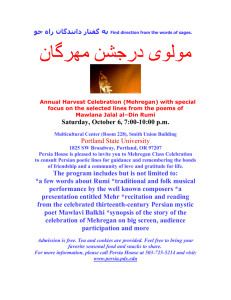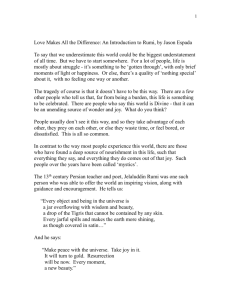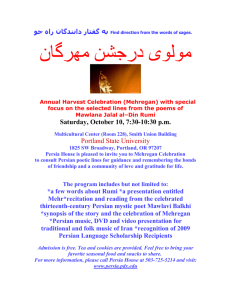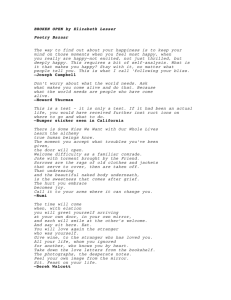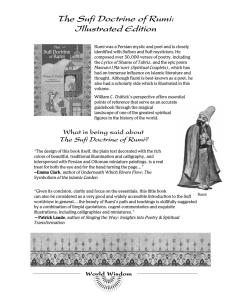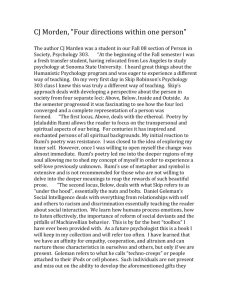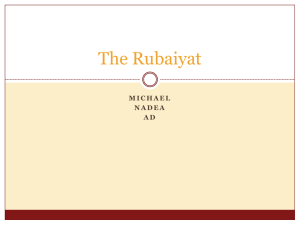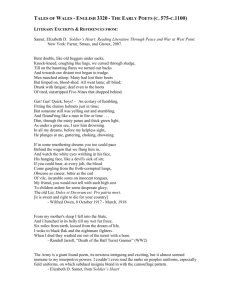TURKEY LESSON PLAN OUTLINE
advertisement
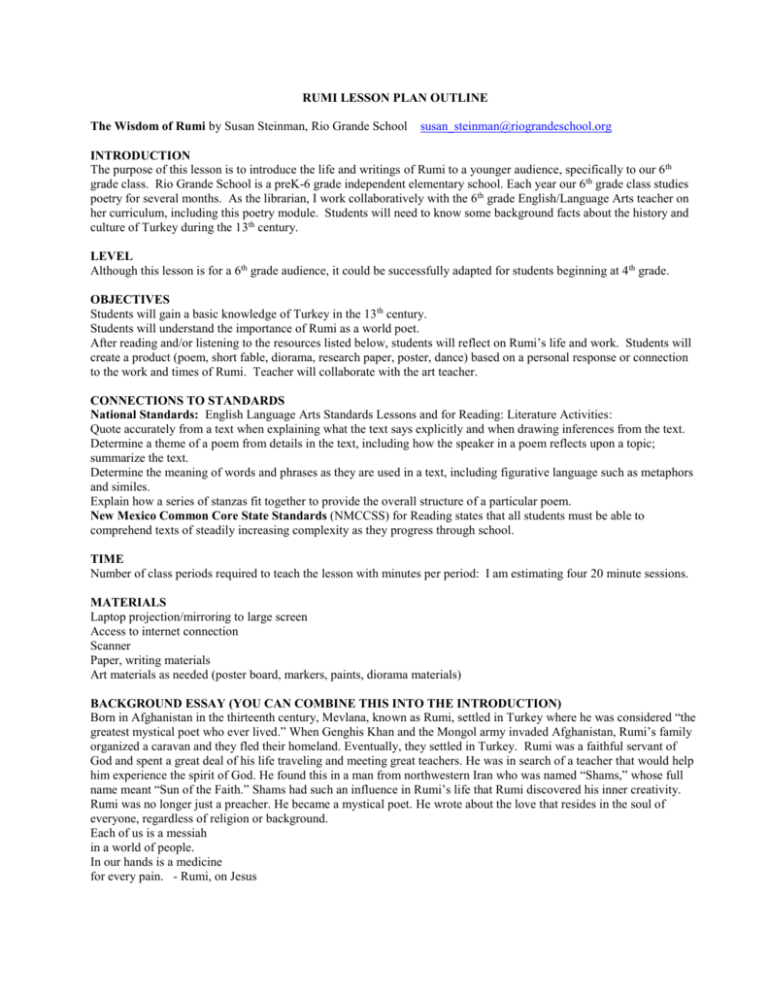
RUMI LESSON PLAN OUTLINE The Wisdom of Rumi by Susan Steinman, Rio Grande School susan_steinman@riograndeschool.org INTRODUCTION The purpose of this lesson is to introduce the life and writings of Rumi to a younger audience, specifically to our 6th grade class. Rio Grande School is a preK-6 grade independent elementary school. Each year our 6 th grade class studies poetry for several months. As the librarian, I work collaboratively with the 6th grade English/Language Arts teacher on her curriculum, including this poetry module. Students will need to know some background facts about the history and culture of Turkey during the 13th century. LEVEL Although this lesson is for a 6th grade audience, it could be successfully adapted for students beginning at 4 th grade. OBJECTIVES Students will gain a basic knowledge of Turkey in the 13 th century. Students will understand the importance of Rumi as a world poet. After reading and/or listening to the resources listed below, students will reflect on Rumi’s life and work. Students will create a product (poem, short fable, diorama, research paper, poster, dance) based on a personal response or connection to the work and times of Rumi. Teacher will collaborate with the art teacher. CONNECTIONS TO STANDARDS National Standards: English Language Arts Standards Lessons and for Reading: Literature Activities: Quote accurately from a text when explaining what the text says explicitly and when drawing inferences from the text. Determine a theme of a poem from details in the text, including how the speaker in a poem reflects upon a topic; summarize the text. Determine the meaning of words and phrases as they are used in a text, including figurative language such as metaphors and similes. Explain how a series of stanzas fit together to provide the overall structure of a particular poem. New Mexico Common Core State Standards (NMCCSS) for Reading states that all students must be able to comprehend texts of steadily increasing complexity as they progress through school. TIME Number of class periods required to teach the lesson with minutes per period: I am estimating four 20 minute sessions. MATERIALS Laptop projection/mirroring to large screen Access to internet connection Scanner Paper, writing materials Art materials as needed (poster board, markers, paints, diorama materials) BACKGROUND ESSAY (YOU CAN COMBINE THIS INTO THE INTRODUCTION) Born in Afghanistan in the thirteenth century, Mevlana, known as Rumi, settled in Turkey where he was considered “the greatest mystical poet who ever lived.” When Genghis Khan and the Mongol army invaded Afghanistan, Rumi’s family organized a caravan and they fled their homeland. Eventually, they settled in Turkey. Rumi was a faithful servant of God and spent a great deal of his life traveling and meeting great teachers. He was in search of a teacher that would help him experience the spirit of God. He found this in a man from northwestern Iran who was named “Shams,” whose full name meant “Sun of the Faith.” Shams had such an influence in Rumi’s life that Rumi discovered his inner creativity. Rumi was no longer just a preacher. He became a mystical poet. He wrote about the love that resides in the soul of everyone, regardless of religion or background. Each of us is a messiah in a world of people. In our hands is a medicine for every pain. - Rumi, on Jesus A whirling dervish ceremony. Rumi felt so close to God that, one day, he began to whirl and circle, turning ’round and ’round, without stopping, for 36 hours. It was a turning point in his life, literally and figuratively. The dance became known as whirling dervishes, and it was a form of prayer to God. He founded the Order of the Whirling Dervishes, who believe that their spinning dances put them in touch with God and brought peace and love into the world. The Whirling Dervishes continue to practice today. A terrible illness took Rumi’s life but his absence was replaced by the gift of unshakeable faith and devotion that he nurtured in the hearts of his students and followers. Rumi’s verses and whirling dervishes serve as an inspiration to people to this day. On the day I die, when I’m being carried toward the grave, do not weep. Do not say, “He’s gone! He’s gone!” Death has nothing to do with going away. The sun sets and the moon sets but they are not gone. Death is a coming together. The following words were inscribed on his tombstone: When we are dead, seek not our tomb in the earth, but find us in the hearts of men. Rumi wrote more than 50,000 rhymed couplets and other poetry as well as a large collection (numbers) of fables that will remind students of Aesop’s fables (600 BCE). An example of Rumi’s poetry appropriate for younger students: You were born with potential You were born with goodness and trust You were born with ideals and dreams You were born with greatness You were born with wings You are not meant for crawling, so don't You have wings Learn to use them and fly! (invite comparison to Dr. Seuss’s Oh the Places You’ll Go): You have brains in your head. You have feet in your shoes You can steer yourself any direction you choose. You're on your own. And you know what you know. And YOU are the [person] who'll decide where to go. And also from Rumi: Look at me and hear me, because I am here ... just for that! PROCEDURES 1. Teacher will ask students to share what they know about the poet Rumi and about Turkey. 2. After a brief discussion, teacher will project images of Turkey and give a synopsis of the complex history and culture appropriate for this developmental level. Suggested use of pages from ebook version of Turkey: Picture Book (Educational Children's Books Collection) - Level 2 (Planet Collection 174) [Kindle Edition], 2012, or scan and project Turkey (Country Explorers) by Madeline Donaldson, Lerner Publications, 2011, or other source. Encourage questions and comments with each page. 3. Teacher will ask students to share what they know about Genghis Khan and the Mongols. Use the 2 minute video clip from Biography.com as background. Encourage questions and comments. http://www.biography.com/people/genghis-khan-9308634 - synopsis 4. Project / mirror either the ebook edition of Rumi: Whirling Dervish by Demi (Kindle for Mac or PC), or scan and project / mirror the book. The book is a brief, illustrated biography of Rumi by a noted and award-winning children’s author. There are 26 pages of text and illustrations. 5. Students will watch a video clip of Whirling Dervishes: https://www.youtube.com/watch?v=fHjFgOfoZ7M Encourage questions and comments. 6. Students will be asked to reflect on what they have learned about Rumi’s life and poetry. Then students will be asked to create something based on what they have learned or have pondered with this knowledge. Art materials, writing materials, etc., will be available for student use. The art teacher will assist in leading this segment. ASSESSMENT Students will be assessed for their level of participation and productivity during these lessons. Student creative work will be assessed for effort and thoughtfulness, based upon individual conferences with students at completion. EXTENSION IDEAS Study Rumi’s fables and invite a comparison to the fables of Aesop. See resources below. SOURCES Bilkan, Ali Fuat editor. Tales from Rumi: Mathnawi Selections for Young Readers. Turhra Books, 2014. Demi. Rumi: Whirling Dervish. Marshall Cavendish, 2009. ebook version available (Kindle) Demi presents this picture-book introduction to the thirteenth-century mystical poet. The author condenses her famous subject’s life into a brief but substantive text. Here, she adds frequent excerpts from Rumi’s poems and writings. Donaldson, Madeline. Turkey. (Country Explorers). Lerner, 2011. Franchino, Vicky. Turkey. (Social Studies Explorer). Cherry Lane Publishing, 2013. Johnson-Davies, Denys. Rumi: Poet and Sage. Hood Hood Books, 2000. Niazi, Negar. Rumi's Fables. CreateSpace Independent Publishing Platform, 2013. A collection of Rumi’s forty-three most magical and charming short stories, Rumi’s Fables comes alive with colorful characters—the sage king, the clever clown, and the bewitched prince—and many talking animals—the wise lion, the cunning fox, and the arrogant mouse. At the end of each story there is a “contemplation box” to make the experience more interactive. There is also a summary of the moral of each story. These stories are reminiscent of the style of Aesop’s fables. Rashin. Two Parrots: inspired by a tale from Rumi. North South Books, 2014. International award-winning illustrator/writer Rashin wants to make sure that even the youngest readers can access and appreciate the timeless poet. To that end, in a simple, contemporary translation illuminated with captivating pictures, Rashin presents a story about love and freedom. Sheehan, Sean. Turkey. (Cultures of the World). Cavendish Square, 2014. Turkey: Picture Book (Educational Children's Books Collection) - Level 2 (Planet Collection 174) [Kindle Edition], 2012. Websites: http://www.biography.com/people/genghis-khan-9308634 - synopsis accessed 9/2014 https://www.youtube.com/watch?v=fHjFgOfoZ7M accessed 9/2014
